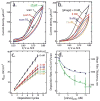Virus-poly(3,4-ethylenedioxythiophene) biocomposite films
- PMID: 22856875
- PMCID: PMC3683562
- DOI: 10.1021/la302473j
Virus-poly(3,4-ethylenedioxythiophene) biocomposite films
Abstract
Virus-poly(3,4-ethylenedioxythiophene) (virus-PEDOT) biocomposite films are prepared by electropolymerizing 3,4-ethylenedioxythiophene (EDOT) in aqueous electrolytes containing 12 mM LiClO(4) and the bacteriophage M13. The concentration of virus in these solutions, [virus](soln), is varied from 3 to 15 nM. A quartz crystal microbalance is used to directly measure the total mass of the biocomposite film during its electrodeposition. In combination with a measurement of the electrodeposition charge, the mass of the virus incorporated into the film is calculated. These data show that the concentration of the M13 within the electropolymerized film, [virus](film), increases linearly with [virus](soln). The incorporation of virus particles into the PEDOT film from solution is efficient, resulting in a concentration ratio of [virus](film):[virus](soln) ≈ 450. Virus incorporation into the PEDOT causes roughening of the film topography that is observed using scanning electron microscopy and atomic force microscopy (AFM). The electrical conductivity of the virus-PEDOT film, measured perpendicular to the plane of the film using conductive tip AFM, decreases linearly with virus loading, from 270 μS/cm for pure PEDOT films to 50 μS/cm for films containing 100 μM virus. The presence on the virus surface of displayed affinity peptides did not significantly influence the efficiency of incorporation into virus-PEDOT biocomposite films.
Figures







Similar articles
-
Virus-poly(3,4-ethylenedioxythiophene) composite films for impedance-based biosensing.Anal Chem. 2011 Apr 1;83(7):2420-4. doi: 10.1021/ac2000835. Epub 2011 Mar 9. Anal Chem. 2011. PMID: 21388148 Free PMC article.
-
Virus-PEDOT nanowires for biosensing.Nano Lett. 2010 Dec 8;10(12):4858-62. doi: 10.1021/nl1025826. Epub 2010 Nov 1. Nano Lett. 2010. PMID: 21038915 Free PMC article.
-
Poly(3,4-ethylenedioxythiophene) (PEDOT) nanobiointerfaces: thin, ultrasmooth, and functionalized PEDOT films with in vitro and in vivo biocompatibility.Langmuir. 2008 Aug 5;24(15):8071-7. doi: 10.1021/la800333g. Epub 2008 Jun 28. Langmuir. 2008. PMID: 18588322
-
Electrochemistry of conductive polymers. 45. Nanoscale conductivity of PEDOT and PEDOT:PSS composite films studied by current-sensing AFM.J Phys Chem B. 2010 Mar 4;114(8):2660-6. doi: 10.1021/jp9113859. J Phys Chem B. 2010. PMID: 20141126
-
Synthesis and electrochemical sensing application of poly(3,4-ethylenedioxythiophene)-based materials: A review.Anal Chim Acta. 2018 Aug 31;1022:1-19. doi: 10.1016/j.aca.2018.02.080. Epub 2018 Mar 14. Anal Chim Acta. 2018. PMID: 29729729 Review.
Cited by
-
Bioinspired Assemblies and Plasmonic Interfaces for Electrochemical Biosensing.J Electroanal Chem (Lausanne). 2016 Nov 15;781:136-146. doi: 10.1016/j.jelechem.2016.05.014. Epub 2016 May 27. J Electroanal Chem (Lausanne). 2016. PMID: 28163664 Free PMC article.
-
Chemically Modifying Viruses for Diverse Applications.ACS Chem Biol. 2016 May 20;11(5):1167-79. doi: 10.1021/acschembio.6b00060. Epub 2016 Mar 21. ACS Chem Biol. 2016. PMID: 26930417 Free PMC article. Review.
-
Virus Bioresistor (VBR) for Detection of Bladder Cancer Marker DJ-1 in Urine at 10 pM in One Minute.Anal Chem. 2020 May 5;92(9):6654-6666. doi: 10.1021/acs.analchem.0c00534. Epub 2020 Apr 20. Anal Chem. 2020. PMID: 32252524 Free PMC article.
-
Biosensing with Virus Electrode Hybrids.Curr Protoc Chem Biol. 2015 Jun 1;7(2):53-72. doi: 10.1002/9780470559277.ch140213. Curr Protoc Chem Biol. 2015. PMID: 26344233 Free PMC article.
-
Sub-nanomolar detection of prostate-specific membrane antigen in synthetic urine by synergistic, dual-ligand phage.J Am Chem Soc. 2013 May 22;135(20):7761-7. doi: 10.1021/ja4028082. Epub 2013 May 13. J Am Chem Soc. 2013. PMID: 23614709 Free PMC article.
References
-
- Cen L, Neoh K, Kang E. Langmuir. 2002;18:8633–8640.
-
- Widge AS, Jefferies-El M, Cui X, Lagenaur CF, Matsuoka Y. Biosens Bioelectron. 2007;22:1723–1732. - PubMed
-
- You J, Yoshida A, Heo JS, Kim HS, Kim HO, Tamada K, Kim E. Phys Chem Chem Phys. 2011;13:17625–17632. - PubMed
-
- Rivers TJ, Hudson TW, Schmidt CE. Adv Funct Mater. 2002;12:33–37.
Publication types
MeSH terms
Substances
Grants and funding
LinkOut - more resources
Full Text Sources
Medical
Miscellaneous

